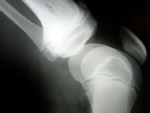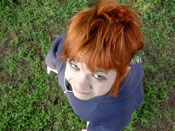Achondroplasia – Living in a tall world
August 2013LIVING WITH A RARE DISEASE

Marco, 40 years old, is the first member of his family to be affected by achondroplasia, a bone growth disorder affecting 1 in every 15 000 births. Though it is an autosomal dominant condition, 90% of patients are born to unaffected parents. Marco’s diagnosis was given right after his birth but he can’t remember when his parents ever told him that he had achondroplasia. “I probably discovered it when I compared myself to my brothers and sister,” Marco says candidly. This rare condition is characterised by a type of dwarfism that can be recognised from the disproportionately short arms and legs, and, often, a large head. Although achondroplasia literally means “without cartilage formation,” the problem in achondroplasia is not in forming cartilage but in converting it to bone, particularly in the long bones.
Bullied, object of stupid jokes, nicknamed… growing up with achondroplasia can be gruelling. “When you are a child, all problems are lightweight and are solved quickly. My worries came later, when I was a teenager. Achondroplasia makes all the normal adolescent problems a little worse. I had my share of stupid jokes but luckily enough, not that often. I think it would have been the same if I were fat or something like that,” recalls Marco. How does Marco refer to himself or another person with achondroplasia? “Person with achondroplasia would be the best term. I know that, for example, in the USA, the word ‘dwarf’ is common but here in Italy, it could be humiliating. So the better way is ‘person’. Of course, I am also a dwarf, male, Italian, white, single…”
 Achondroplasia patients often get the feeling of living in a “tall” world. “It is a problem for most of us. We can’t reach shelves in shops, the size of clothes is not suitable for us, and we sometimes have to adjust our house. Buying special clothes or altering the house can be expensive… But it’s not a financial problem only of course. In some countries, having a coffee in a bar or taking the bus can be difficult too,” says Marco.
Achondroplasia patients often get the feeling of living in a “tall” world. “It is a problem for most of us. We can’t reach shelves in shops, the size of clothes is not suitable for us, and we sometimes have to adjust our house. Buying special clothes or altering the house can be expensive… But it’s not a financial problem only of course. In some countries, having a coffee in a bar or taking the bus can be difficult too,” says Marco.
Luckily, Marco is safe from some of the health problems that achondroplasia patients usually deal with: breathing difficulties (apnea), recurrent ear infections, back pain, lack of stability, or spinal stenosis. Surgery is sometimes used to correct specific skeletal deformities (for example, bowed legs) and prevent spinal compression. Some achondroplasia patients go through limb- and arms-lengthening operations, but still, says Marco, “it is not enough to be comfortable in the environment around us.” Marco had surgery when he was 14. “It was in 1982, and I had to go to Siberia to have the surgery because it did not exist in Europe. It was very painful. My mother and I stayed away from home for 9 months. The important thing is to remember that this kind of operation helps you to live better but doesn’t resolve the condition. Now in some countries of Europe (Italy, Spain) there are hospitals where you can have this kind of operation,” Marco says.
 Marco works as a Business Consultant in a multinational company. He also works as a volunteer for the Associazione per l’Informazione e Lo Studio sull’Acondroplasia (AISAC, a Eurordis member), an Italian association for people with achondroplasia. “I have always been an activist, in particular in fighting against my disease. I remember my first time at a Eurordis meeting some years ago where I really understood how important scientific research is, how a particular law could resolve problems for many rare disease patients and also how unequal a combat it is to obtain a little bit of attention from some researchers and pharmaceutical industries.” When he is not fighting for the “value of diversity in society,” as Marco says, or watching closely the different medical and social studies on achondroplasia patients, Marco is just a regular guy. “I hope to have a stimulating job with a good salary, take a world tour on my sailing boat, and live in a better world…
Marco works as a Business Consultant in a multinational company. He also works as a volunteer for the Associazione per l’Informazione e Lo Studio sull’Acondroplasia (AISAC, a Eurordis member), an Italian association for people with achondroplasia. “I have always been an activist, in particular in fighting against my disease. I remember my first time at a Eurordis meeting some years ago where I really understood how important scientific research is, how a particular law could resolve problems for many rare disease patients and also how unequal a combat it is to obtain a little bit of attention from some researchers and pharmaceutical industries.” When he is not fighting for the “value of diversity in society,” as Marco says, or watching closely the different medical and social studies on achondroplasia patients, Marco is just a regular guy. “I hope to have a stimulating job with a good salary, take a world tour on my sailing boat, and live in a better world…
This article was previously published in the December 2007 issue of our newsletter.
Author: Nathacha Appanah
Photo credits: Bone © Clara Natoli; Francesca © Moscardo/Eurordis; Marco © Marco
